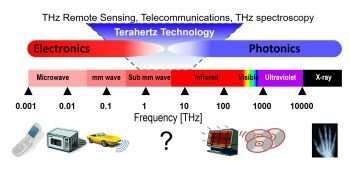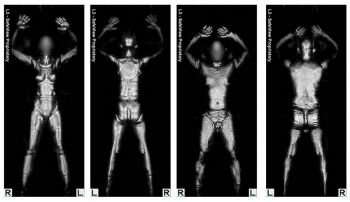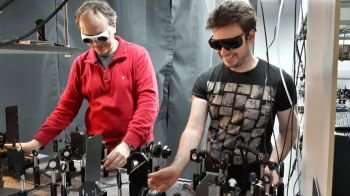Physicists explore a safe alternative to X-ray security scanners

A team of physicists at the University of Sussex are developing the science to create a safe and efficient 'paint' that can reveal, with terahertz (THz) radiation, the contents of luggage or objects hidden in clothing.
THz radiation could replace the use of harmful X-rays and ultraviolet light in security scanners. It cannot pass through water, which is why it does not pose a health risk to living tissue, but it can penetrate fabrics, plastics and wood to give internal images similar to an X-ray.
Lying between microwaves and infrared in the electromagnetic spectrum it, as with all other radiation, travels at the speed of light—but has a lower frequency than X-rays and ultraviolet.
Although its existence has been known for decades, the technology to harness it and use it in a meaningful capacity has not been readily available.
However, a team at the Emergent Photonics Laboratory at the University of Sussex have come up with a simple demonstration that shows how the surfaces of objects up to any size can potentially be made into bright terahertz emitters.
Thin semiconductors, which are materials that have a conductivity between metals (as very good conductors) and glass (which has no conductivity), are bright emitters that could be "painted" onto inexpensive materials to do the trick.

Doctoral research student Luke Peters, the lead author of a paper published in Nano Energy, says: "Our challenge is to make terahertz emanate from common objects such as walls or pieces of paper.
"We have found that it is practically possible to create terahertz in significant amounts by illuminating ultrathin electronic semiconductors, which could simply be placed upon any surface."
In practical terms, this means that instead of travellers passing through electromagnetic scanners at airports, they could simply walk on a pathway or aside walls coated with terahertz-emitting materials.
The discovery could help to develop many other applications, from detecting fraud in art by illuminating beneath the layers of paint, to preventing counterfeiting in currency by incorporating ink that emits terahertz.

There are also potential uses in the medical world. Terahertz has been proposed in dentistry to identify cavities in teeth, and to help surgeons in detecting specific tumours, which have a higher water content than normal body tissue and are therefore visible under terahertz radiation.
Professor Marco Peccianti, the team leader at the Emergent Photonics Lab, said: "With Luke's paper being published in such a prestigious journal, this is an exciting time for our team.
"There is a consensus that terahertz is still very much in its youth. The first terahertz image was only created in 1993, and what we call intense terahertz is still a tiny amount compared to what is available from light sources. To us, placing terahertz on large surfaces is the challenge. In Sussex we aim to make this cheaper, effective and practical."
More information: L. Peters et al. High-energy terahertz surface optical rectification, Nano Energy (2018). DOI: 10.1016/j.nanoen.2018.01.027
Journal information: Nano Energy
Provided by University of Sussex



















